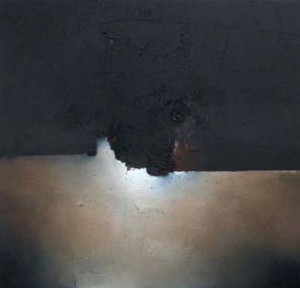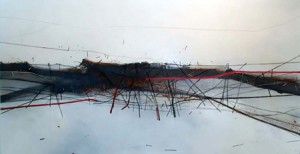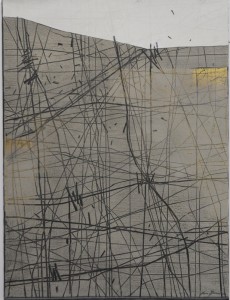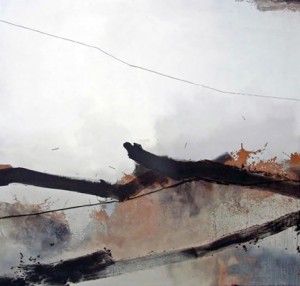In the late 1950’s, the artist Adolph Gottlieb told Selden Rodman, “We are going to have perhaps a thousand years of non representational paintings.” Well so much for the hubris of those days, but then it really did seem as though abstract expressionism (the stuff of Kandinsky) would never go away. Fresh, vibrant abstract paintings still smelling of the studio brought viewers into a truly wondrous world at gallery after gallery. I remember.
I also remember seeing Ed Kienholz’s 1966 exhibit at LACMA and being as flummoxed as anyone else upon viewing his “Backseat Dodge ‘38” piece. But, like most persons at the time, I knew that Gottlieb’s prophecy was in doubt. All was not completely gone for the abstract expressionists; great artists such as Sean Scully or Cy Twomly still emerged. But now one saw trite “formula” abstract expressionistic knock-offs containing ever less substance. Little wonder that I revel when I walk into a gallery and see an artist’s work that resurrects the feelings I used to get from such as Joan Mitchell, Phillip Guston, Robert Motherwell, or AntonioTapias, artists in whose works one clearly hears the music of the spheres.
When I recently walked into ADC Contemporary Art Gallery, a gem of a gallery deeply hidden in the L.A. downtown art district, I heard those familiar chords being created by the recent works of the Mexican artist Francisco Romero in his solo show “Breathing Walls.” Here was an artist with, of all things, a PhD in Visual Arts and Inter-Media from Spain.
 His art, consisting of a mix of small and large paintings, is bold and direct but not without an abundance of subtlety built into it. The paintings are about visual balance between busy groups of smallish things that get critically positioned within larger rather homogeneous spaces. Romero sees his forms as essentially organic, but from my viewpoint they can just as easily represent inorganic shapes, as the line between both is quite narrow. All of his paintings are abstracts that inevitably suggest structures and landscapes in one’s mind.
His art, consisting of a mix of small and large paintings, is bold and direct but not without an abundance of subtlety built into it. The paintings are about visual balance between busy groups of smallish things that get critically positioned within larger rather homogeneous spaces. Romero sees his forms as essentially organic, but from my viewpoint they can just as easily represent inorganic shapes, as the line between both is quite narrow. All of his paintings are abstracts that inevitably suggest structures and landscapes in one’s mind.
 Romero’s preoccupation with the small as organized within large fields creates quite a study in the “dynamic,” where it’s impossible to say whether the detailed parts unify the whole or the whole unifies the details. In the world of Gestalt, there are no dangling parts in his paintings.
Romero’s preoccupation with the small as organized within large fields creates quite a study in the “dynamic,” where it’s impossible to say whether the detailed parts unify the whole or the whole unifies the details. In the world of Gestalt, there are no dangling parts in his paintings.
 Just as significant is how seriously he considers the surface treatment of his paintings. Using natural and rust oxide pigments along with marble dust, graphite, and pencil, he achieves a formidable texture to each painting. This energetic effort on the surface pays big dividends when the works are viewed from up close.
Just as significant is how seriously he considers the surface treatment of his paintings. Using natural and rust oxide pigments along with marble dust, graphite, and pencil, he achieves a formidable texture to each painting. This energetic effort on the surface pays big dividends when the works are viewed from up close.
Of his work Romero states, “(My) inspiration comes from an exploration of the spiritual conflict faced by contemporary man and the every day chaos of life.” This is an interesting statement coming from an artist who creates works of such defined stability and unification. Perhaps it was chaos that motivated him but he has managed, with considerable skill, to create art that looks and feels antipodal to chaos. For Francisco Romero, his work is apparently a process of conflict reconciliation but from the standpoint of the viewer, all seems happily and grandly resolved.


Thanks for this! Loved first and last paintings. Will check out this gallery
Jennifer
Will definitely see this show; thanks Rene.
Rene, You are getting better and better in your write-ups. Eventually your should perhaps write a book on selected artists.
romero’s work appeals to me tremendously, especially “Vertigo.” As usual, I like your comments. Ishall show this post to my young student, Emma, age 15 (soon 16) who is really interested and “talented.”